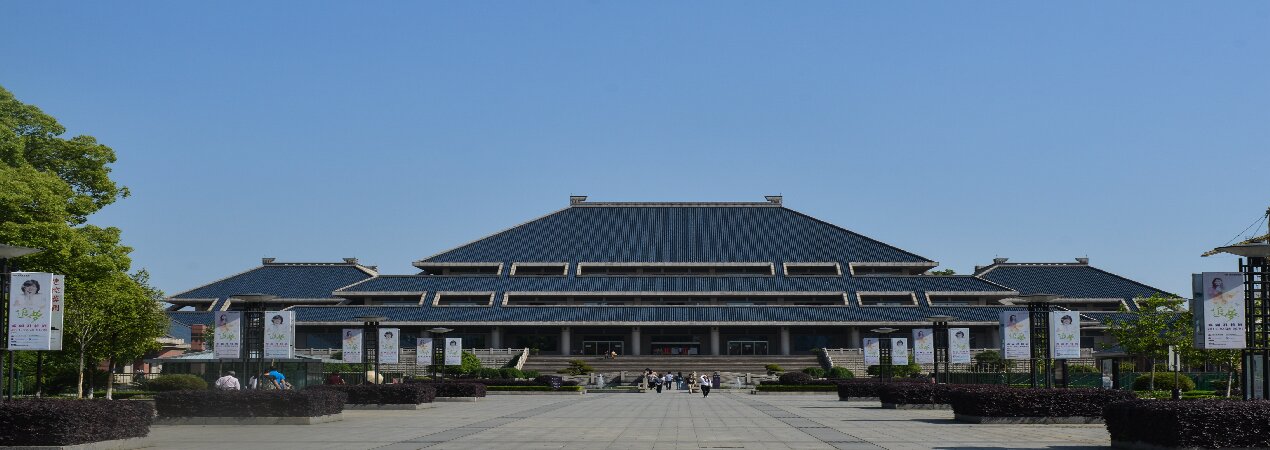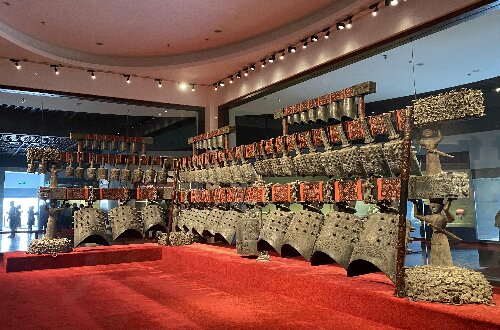Hubei Provincial Museum

Hubei Provincial Museum, located in the East Lake Scenic Area of Wuhan City, was established in 1953. It is one of the eight national museums jointly built by the central government and local governments across the country. It is the only provincial comprehensive museum in Hubei Province, and also a cultural relics collection, research and exhibition institution, as well as a national 4A-level tourist scenic area.
Hubei Provincial Museum has more than 240,000 pieces (sets) of cultural relics in its collection, and nearly 1,000 pieces (sets) of cultural relics at the national first-class level. As of February 2023, the total land area of the museum is 85,000 square meters, and the total building area is 114,000 square meters, among which the exhibition area is 36,000 square meters. The museum buildings are generally arranged in the pattern of the South Hall, the North Hall, and two independent exhibition halls in the east and west.
- Chinese name: 湖北博物馆 Húběi Bówùguǎn
- Suggested time: 1-2 hours
- Ticket: Free (Online reservation required)
- Open hours: 9:00-17:00 (Closed on Mondays)
- The best time to visit: All year round
- Address: No. 160, East Lake Road, Wuchang District, Wuhan, Hubei, China
- How to get there: Take Metro Line 8 to Hubei Provincial Museum Station, then walk for about 5 minutes
Highlights of Hubei Provincial Museum
The Chu Culture Hall
As one of the exhibition halls of Hubei Provincial Museum, the Chu Culture Hall was completed and opened to the public in December 2005. The State of Chu was conquered by the State of Qin in 223 BC, and it had existed as an independent state for approximately 800 years.
Since the 1960s, more than 5,000 Chu tombs have been excavated in Hubei Province, and a large number of unearthed cultural relics have presented various aspects of the social life of the State of Chu. As a regional culture in the Pre-Qin period, Chu culture is unique and profound, and it is an important part of the Pre-Qin Huaxia civilization.
This exhibition is divided into eight parts, which centrally display the essence of Chu cultural relics unearthed in the Hubei region, striving to comprehensively showcase the glory of Chu culture. Among the exhibits are the Sword of Goujian, King of Yue, the Spear of Fuchai, King of Wu and some restored chariots and horses from the Chu chariot and horse pit that was excavated in Jiuliandun, Zaoyang, Hubei Province in 2002.
The Yunxian Man
The Yunxian Man refers to ancient humans from the early Paleolithic period found in the middle and lower reaches of the Yangtze River and belonging to Homo erectus. In 1989 and 1990, two human skull fossils were successively discovered at Xuetangliangzi, the estuary of the Quyuan River in Qingqu Town, Yunxian County. The site dates back about one million years. The exhibition "The Yunxian Man" takes the discovery of the Yunxian Man as its main theme and also showcases the discoveries of Paleolithic remains in Hubei Province.
The Tomb of Marquis Yi of Zeng
 The Chime Bells of Marquis Yi of Zeng
The Chime Bells of Marquis Yi of ZengThe Tomb of Marquis Yi of Zeng is the burial site of a feudal lord who lived 2,400 years ago. The owner of the tomb was Yi, the marquis of the State of Zeng in the early Warring States Period. More than 10,000 cultural relics of various kinds were unearthed from this tomb. The large quantity and high value of these cultural relics caused a sensation both at home and abroad.
The exhibition of the Tomb of Marquis Yi of Zeng displays the most representative cultural relics unearthed from the tomb, presenting the spiritual world and material life of people 2,400 years ago. The exhibition is divided into eight major parts: the Sacrificial Hall, Bronze Wares, Weapons, Chariots and Horse Equipments, Bamboo Slips, Lacquer and Wooden Wares, Gold and Jade Wares, and Musical Instruments. A total of 360 of the most representative cultural relics are on display.
In particular, a set of bronze chime bells among the musical instrument exhibits is truly a priceless treasure. With a wide range of tones and beautiful timbre, it can play various Chinese and foreign musical pieces and is praised as a great wonder in the history of world music.
Drop us a line and we'll connect you with the top China expert in no time!